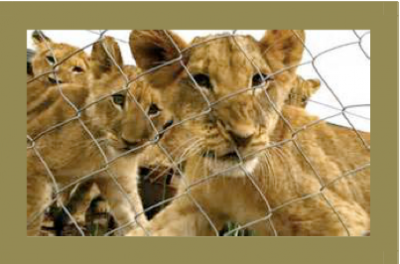|

"There’s gold in them thar lions….."
I was asked this question today, and I decided to make a “back of the envelope” calculation. I have always taken the most conservative estimate, but assume that each lion is marketed to their full potential.
So how does a male lion, let’s call him Rex, make money?
1. Rex is born to a female in a captive breeding facility. Within days he is taken away from his mother because he now needs to be presented as an “orphan” to be raised by paying volunteers. Each volunteer pays a minimum of $1,000 per week, and there are often minimally 5 volunteers at a time at the breeding farms. Let’s say Rex is part of a litter of 4 “orphans” and gets attended by volunteers for about 6 months. Value for Rex = $30,000.
2. Rex is then placed in a petting farm. Let’s say Rex’s owners charge people $5 for a petting/photographic opportunity, and there are about 100 people per week who engage in this. Rex does this petting business for about 6 months. Rex might also be rented out to “functions” like weddings and corporate parties. Rex is not the only lion being petted. Value for Rex = $18,000.
3. Rex then goes on lion “walks” for about 2 years. These are offered for an average of $100 per hour per person, so let’s say Rex walks around for 200 days a year with 5 people per day. Rex is not the only lion walking, so his individual value might go down a bit. Value for Rex = $50,000.
4. When Rex gets too big and dangerous to walk, perhaps he can then go to a “sanctuary” where he can be visited by people who now see him behind a fence while he is growing to a “nice” trophy size. Admission is $5 per person, minimum 20 people per day, and Rex stays there for about 2 -3 years. There are other lions there, so his individual value is lessened. Value for Rex = $30,000.
5. Rex is then sold to a trophy hunter. Depending on the size of his body and his mane, Rex can fetch a minimum of about $17,000.
6. The hunter only wants the skin and perhaps the skull. So Rex’s bones are then sold for about $2,000.
So how much is Rex worth over his caged lifetime? At a very minimum $147,000.
It is estimated that there are about 7,000 lions in captivity in South Africa. One would expect that half of those are female, but it is highly probable that female lions are “snuffed” at an early age. They can be “used” for volunteers and petting and walking, but then do not have much additional value as trophies. A female lion trophy is sold for about $5,000 and demand is low. But some females are required to do the breeding, so a few females per year born on the farms might be recruited onto the assembly line.
So how much is a female lion worth? Let’s call her Regina.
Regina has all the “early” value that Rex does, but then loses value in later life unless she’s used for breeding. So Regina, over her lifetime, can be expected to earn maybe $130,000. Her bones and skin are still valuable after she has been “terminated” earlier than Rex.
The breeders will say that Rex and Regina cost money during their lives. They need food, maybe some veterinary care, staff costs, fencing costs, insurance for the facilities, etc, etc ,etc.
So let’s say that Rex and Regina, as individual lions, cost the breeders an average of $8,000 per year. That’s very generous.
This would mean that Rex brings in a net profit of $107,000 minimum over his five year life and Regina brings in a profit of $90,000 minimum, more if she only lives for 2-3 years.
I have not brought into this calculation the alternative to trophy hunting – Rex and Regina could be sold to a diversity of dubious zoos, or to circuses, or to private owners in the Arab Emirates for example.
Nice money. No wonder, with something like 7,000 lions caged in South Africa, that the breeders want to keep this industry going and growing?
What should also apparent from this analysis is that the trophy hunting value is only a small percentage compared to the “early life” value of a lion in South Africa. In other words, Rex and Regina earn more money to be attended by volunteers, petted and walked compared to their value as trophies. Think about that.
Banning canned hunting will still leave a huge profit margin for captive lion breeders. That is something for local South African conservation organizations to get serious about addressing.
Picture credit: right-tourism.com
|




